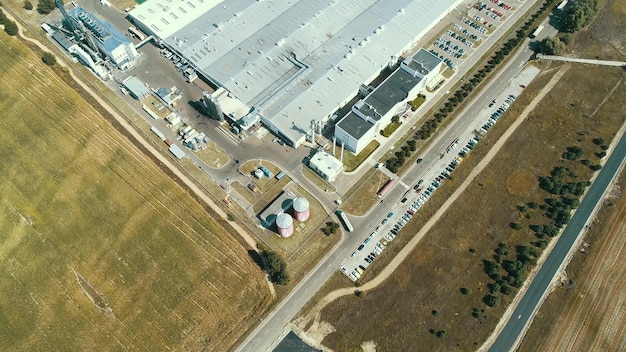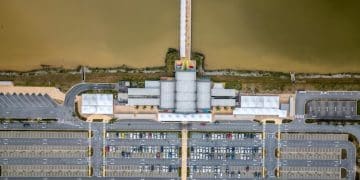Mexico’s Real Estate Market: Opportunities for US Investors

Mexico’s real estate market presents dynamic opportunities for US investors in both commercial and residential sectors, fueled by nearshoring, tourism growth, and a favorable exchange rate, demanding careful due diligence and strategic planning.
The allure of the Mexican real estate market for US investors is increasingly undeniable, offering a compelling blend of proximity, economic growth, and attractive valuations. From burgeoning industrial hubs to serene coastal retreats, Mexico’s Real Estate Market: Opportunities for US Investors in Commercial and Residential Properties are diverse and ripe for exploration.
The evolving landscape of Mexico’s real estate market
Mexico’s real estate market is undergoing a significant transformation, driven by an interplay of global economic shifts and internal dynamics. This evolution presents unique entry points for discerning US investors, distinct from traditional investment narratives. Understanding these foundational changes is crucial for strategic deployment of capital.
The market’s resilience, even amidst global uncertainties, speaks volumes about its underlying strengths. Factors like a growing middle class, increased urbanization, and supportive government initiatives contribute to a robust environment where real estate can flourish.
Macroeconomic drivers and their impact
Several macroeconomic factors are converging to create a favorable climate for real estate investment in Mexico. These forces extend beyond simple supply and demand, influencing long-term value and stability.
- Nearshoring trend: The strategic shift of manufacturing and supply chains closer to end markets, particularly from Asia to North America, is a monumental driver. Mexico benefits immensely from this, leading to increased demand for industrial, logistics, and residential properties near new manufacturing plants.
- Population demographics: A youthful and growing population base fuels demand for both residential and commercial spaces. As more Mexicans enter the workforce and achieve economic mobility, housing needs expand, and local consumption drives retail and service sector growth.
- Tourism resurgence: Post-pandemic, Mexico’s tourism sector has experienced a powerful rebound. This not only directly impacts hospitality real estate but also boosts demand for vacation rentals and related infrastructure in popular destinations.
Regional disparities and growth pockets
It’s vital to recognize that Mexico’s real estate market is not monolithic. Growth is concentrated in specific regions, each offering distinct advantages and risk profiles. Investors must conduct thorough due diligence to identify the areas best aligned with their investment goals.
Understanding these regional nuances helps in formulating a targeted investment strategy. From the industrial north to the tourist-heavy south, each area presents a different set of opportunities and challenges.
The government’s focus on infrastructure development in these key regions further enhances their appeal. New highways, airports, and public services contribute to increased property values and improved quality of life.
Residential investment: A closer look at opportunities and challenges
Investing in residential properties in Mexico offers a diverse spectrum of possibilities, from luxury beachfront villas to affordable urban apartments. Each sub-segment caters to different investor profiles and market demands. Navigating this landscape requires an understanding of local customs, legal frameworks, and evolving consumer preferences.
The appeal is multi-faceted, ranging from potential rental income to capital appreciation, driven by tourism or local population growth. However, it’s not without its complexities, including property management in a foreign country and understanding local landlord-tenant laws.
High-growth residential markets for US investors
Certain Mexican regions consistently attract US buyers due to their unique appeal and established infrastructure. These areas often offer a blend of lifestyle benefits and strong investment potential.
- Coastal hot spots (e.g., Riviera Maya, Puerto Vallarta, Los Cabos): These destinations benefit from robust international tourism, driving demand for vacation rentals and second homes. Properties here tend to command higher prices but offer significant rental income potential, especially from platforms like Airbnb.
- Border cities (e.g., Tijuana, Ciudad Juárez): The growth in nearshoring is spurring demand for housing for workers and executives in these industrial hubs. While perhaps less glamorous than coastal areas, they offer strong long-term rental yields and consistent occupancy rates driven by economic activity.
- Colonial cities (e.g., San Miguel de Allende, Oaxaca): Popular with expats and retirees seeking cultural immersion and a slower pace of life. Properties in these areas often hold historical charm and appreciate due to their unique appeal and controlled development.
Navigating the purchase process and legal considerations
The process of acquiring residential property in Mexico differs significantly from the US. Foreign ownership rules, trust arrangements, and local legal nuances must be thoroughly understood to ensure a smooth and secure transaction.
It’s imperative for US investors to work with qualified professionals, including real estate agents, attorneys specializing in Mexican property law, and financial advisors. This team can guide them through the complexities. The concept of a fideicomiso, or bank trust, is particularly important for property ownership within restricted zones (e.g., within 50 km of the coastline or 100 km of a border).
Due diligence should extend beyond the property itself to verifying the developer’s reputation, checking for any liens or encumbrances, and understanding local zoning regulations. Property taxes (predial) are generally lower than in the US, but transfer taxes and closing costs can be substantial.
Commercial property opportunities: Beyond the traditional
The commercial real estate sector in Mexico is experiencing a surge, particularly in industrial and logistics segments, propelled by global trade dynamics. This offers a distinct set of opportunities for US investors looking for higher yields and less direct management than residential single-family homes.

Understanding the specific drivers for each commercial segment is key. While retail and office spaces remain relevant, the current sweet spot for foreign investment lies in areas supporting manufacturing and distribution.
The rise of industrial and logistics real estate
This segment is arguably the most dynamic in Mexico’s commercial real estate market today. The nearshoring phenomenon has created unprecedented demand for industrial parks, warehouses, and distribution centers.
Multinational corporations are establishing or expanding manufacturing facilities in Mexico to shorten supply chains, reduce transportation costs, and mitigate geopolitical risks. This directly translates into a need for high-quality industrial space, often built to international standards.
Key areas experiencing this boom include cities along the US border like Tijuana, Ciudad Juárez, and Monterrey, as well as central Mexico industrial corridors such as Querétaro and San Luis Potosí. Investments in build-to-suit facilities, specialized cold storage, or modern logistics hubs can yield attractive returns.
Retail and hospitality: Niche investments and recovery trends
While industrial real estate leads, retail and hospitality also present intriguing, albeit more nuanced, opportunities. Both sectors are closely tied to consumer spending and tourism recovery.
Retail investments can be strong in areas with growing middle-class populations or high tourist footfall. Niche retail developments, such as lifestyle centers or mixed-use projects incorporating residential and retail elements, are performing well. Understanding local consumer habits and preferred retail formats is essential for success in this segment.
The hospitality sector, especially in coastal areas and major cities, is benefiting from the resurgence in travel. Investments can range from boutique hotels to large-scale resorts, or even specialized medical tourism facilities. The key here is identifying underperforming assets with turnaround potential or new developments in high-growth tourism markets.
Both retail and hospitality require a deep understanding of local market dynamics and strong operational management. Partnerships with experienced local operators can significantly mitigate risks and enhance returns.
Understanding the economic and regulatory framework
Investing in a foreign country necessitates a comprehensive understanding of its economic stability, regulatory environment, and potential risks. Mexico, like any emerging market, presents a unique blend of opportunities and challenges that investors must carefully assess.
A stable economic environment coupled with clear and predictable regulations forms the bedrock of a secure investment. Without this transparency, even the most attractive opportunities can be fraught with unforeseen complications.
Economic stability and foreign exchange considerations
Mexico’s economy has demonstrated remarkable resilience and growth trajectory, making it an attractive destination for foreign direct investment. The country boasts a diverse economy, strong manufacturing base, and increasingly robust service sector.
- GDP growth: Consistent, albeit sometimes modest, GDP growth provides a stable foundation for real estate appreciation. This growth is often supported by robust exports, domestic consumption, and infrastructure spending.
- Inflation and interest rates: While inflation can be a concern in any economy, Mexico’s central bank has generally adopted prudent monetary policies. Understanding the inflation outlook and its impact on interest rates is crucial for financing considerations and rental income projections.
- Peso-dollar exchange rate: The exchange rate between the Mexican Peso and the US Dollar is a significant factor for US investors. A favorable exchange rate makes Mexican properties more affordable in dollar terms, potentially boosting returns upon sale if the peso appreciates. However, currency fluctuations also introduce currency risk, which must be factored into financial models.
Legal and regulatory clarity for foreign investors
Mexico has made considerable strides in creating a more predictable and investor-friendly legal framework. However, foreign investors still need to be aware of specific regulations and engage local expertise.
Key legal aspects include foreign investment laws, property ownership regulations (especially for coastal and border areas necessitating a fideicomiso or bank trust), and environmental regulations. It is critical to work with experienced Mexican legal counsel to ensure compliance and protect investments from potential disputes or legal challenges.
Taxation is another important consideration. US investors should understand Mexican property taxes (predial), income taxes on rental revenue, and capital gains taxes on property sales. Double taxation agreements between the US and Mexico can mitigate some of these burdens, but professional tax advice tailored to individual circumstances is essential.
Risk mitigation and due diligence strategies for US investors
While the opportunities in Mexico’s real estate market are compelling, successful investment hinges on robust risk mitigation and a comprehensive due diligence process. Overlooking these crucial steps can lead to costly mistakes and undermine otherwise promising ventures.
A proactive approach to identifying and addressing potential pitfalls is paramount. This involves not only financial and legal scrutiny but also cultural awareness and local market intelligence.
Conducting thorough due diligence
Due diligence in Mexico involves a multi-layered approach, going beyond what might be customary in a US transaction. It encompasses legal, financial, and physical aspects of the property and its surrounding environment.
- Legal due diligence: This includes verifying clear title, checking for any existing liens or encumbrances, ensuring permits and licenses are in order, and confirming compliance with zoning laws. A reputable Mexican attorney is indispensable for this step.
- Financial due diligence: Beyond the purchase price, this involves analyzing potential operating expenses, property taxes, maintenance costs, and projected rental income. For commercial properties, a detailed cash flow analysis and tenant creditworthiness review are vital.
- Physical inspection: A professional property inspection is critical to identify structural issues, needed repairs, and potential environmental concerns. This is particularly important for older properties or those in coastal areas prone to specific climate challenges.
Protecting your investment: Insurance, trusts, and local partnerships
Once due diligence is complete and an investment decision is made, implementing protective measures is crucial. Diversifying risk and leveraging local expertise can significantly enhance security.

Property insurance tailored to Mexican conditions is a must, covering natural disasters, liability, and other relevant risks. For properties in restricted zones, holding ownership through a fideicomiso offers a secure legal framework recognized by Mexican law for foreign investors.
Developing strong relationships with reputable local professionals—including real estate brokers, property managers, attorneys, and accountants—is perhaps the most vital form of protection. These partnerships provide invaluable local insights, navigate administrative complexities, and offer ongoing support, ensuring the investment is managed effectively and in compliance with local regulations.
Finally, understanding exit strategies from the outset is prudent. Whether it’s selling to another foreign investor, a local entity, or a development company, having a clear plan for divesting the asset minimizes future complications and maximizes potential returns.
Future outlook and long-term considerations
The trajectory of Mexico’s real estate market appears promising, but long-term success for US investors will depend on adaptability and foresight. Understanding emerging trends and potential shifts is key to sustaining investment value over time.
The market is dynamic, reflecting global economic shifts and internal policy changes. Therefore, a forward-looking perspective is essential for making informed decisions that transcend immediate gains.
Emerging trends and growth drivers
Several significant trends are poised to shape Mexico’s real estate landscape in the coming years. Investors who recognize and capitalize on these will likely see enhanced returns.
- Sustainable development: Growing demand for eco-friendly and energy-efficient properties is pushing developers towards sustainable construction practices. Investments in green buildings or properties adaptable to renewable energy sources may see increased value and appeal.
- Technology integration (PropTech): The adoption of property technology (PropTech) is streamlining real estate operations, from digital transactions to smart home features and AI-driven property management. Embracing these technologies can offer competitive advantages and operational efficiencies.
- Infrastructure development: Continued government and private sector investment in infrastructure—including improved transportation networks, energy grids, and digital connectivity—will unlock new areas for development and enhance the value of existing properties.
Potential challenges and navigating the future market
While the outlook is positive, challenges remain. Investors must stay informed and agile to navigate potential headwinds effectively.
Geopolitical shifts, economic fluctuations, and changes in trade policies could impact market stability. Staying abreast of these broader developments and their potential effects on Mexico’s economy is vital. Similarly, local political shifts and regulatory changes specific to real estate could introduce new complexities.
Competition in attractive investment areas may intensify, potentially pushing up prices and compressing yields. Therefore, identifying undervalued or emerging markets before they become mainstream will be crucial for securing optimal returns. Continuous market research, expert local advice, and a willingness to adapt investment strategies will be key to long-term success in this dynamic and rewarding market.
| Key Aspect | Brief Description |
|---|---|
| 📈 Market Drivers | Nearshoring, strong tourism, and favorable demographics fuel demand in both sectors. |
| 🏠 Residential Niche | Coastal resorts, border cities, and colonial towns offer varied investment opportunities. |
| 🏭 Commercial Growth | Industrial and logistics properties are booming due to strong nearshoring demand. |
| ⚖️ Investor Safeguards | Thorough due diligence, legal counsel (fideicomiso), and local partnerships are critical. |
Frequently asked questions about investing in Mexico real estate
▼
Yes, directly in most areas. However, for properties within 100 km of a border or 50 km of the coast, foreign ownership typically requires a “fideicomiso” (bank trust). This trust arrangement grants beneficial ownership to the foreign investor, allowing them full rights to use, sell, and inherit the property, making the process secure.
▼
Challenges include navigating different legal systems, understanding local tax implications, managing currency fluctuations, and property management from a distance. It’s crucial to engage experienced local professionals like real estate agents, attorneys specializing in Mexican law, and accountants to mitigate these risks effectively.
▼
Currently, industrial and logistics properties are highly promising due to the nearshoring trend, which is driving demand for warehouses, distribution centers, and manufacturing facilities across various regions. Retail and hospitality also offer opportunities, but often require more niche targeting and understanding of local consumer and tourism dynamics for success.
▼
Nearshoring is a pivotal driver, as it involves companies relocating their manufacturing and supply chains from distant regions (like Asia) closer to their main markets (the US). This creates massive demand for industrial real estate, but also spurs residential development for workers and executives, alongside increased demand for supporting commercial services in these growing hubs.
▼
Yes, property taxes (predial) in Mexico are generally much lower than in the US, often representing a small percentage of the property’s assessed value. However, closing costs and transfer taxes can be higher, typically ranging from 4% to 8% of the property value. It’s essential to budget for these upfront costs when planning an investment.
Conclusion
Mexico’s real estate market offers a compelling and multifaceted landscape for US investors, marked by a confluence of favorable economic drivers and evolving opportunities. From the robust growth in industrial properties fueled by nearshoring to the enduring appeal of residential and hospitality sectors in prime tourist and urban centers, the potential for significant returns is clear. Successful navigation of this market hinges on thorough due diligence, a deep understanding of local regulations, and the strategic formation of partnerships with experienced local professionals. While challenges exist, the proactive investor, armed with knowledge and reliable guidance, can unlock the immense value Mexico’s diverse real estate market holds for both commercial and residential ventures.





